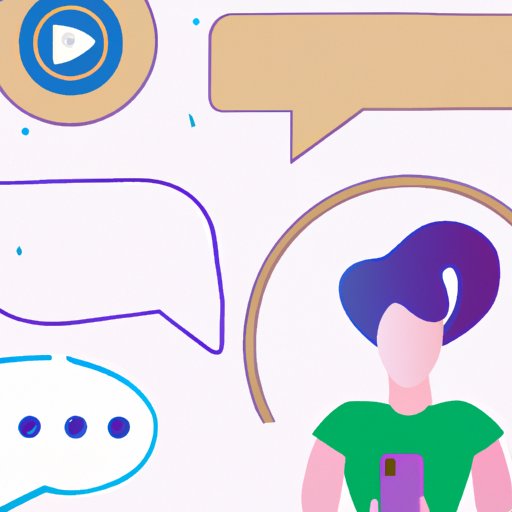Introduction
The advancement of technology has had a profound impact on the way people communicate. From smartphones to video chatting, social media to text messaging, technology has enabled people to stay connected with one another in ways that were not possible before. In this article, we will explore how technology has changed communication, examining the pros and cons of each type of technology.

Examining the Impact of Smartphones on Communication
Smartphones have revolutionized communication. According to a study by Pew Research Center, “90% of Americans now own a cellphone of some kind, and 77% own a smartphone.” This means that more people than ever before are able to communicate with one another instantly and conveniently. Smartphones also provide a variety of apps that allow users to stay connected with friends and family, such as messaging apps like WhatsApp, Snapchat, and Facebook Messenger.
These apps have made it easier for people to stay in touch with one another, no matter where they are or what time it is. For example, WhatsApp allows users to send messages, photos, videos, and voice recordings over Wi-Fi or cellular networks, making it easy to keep in touch with loved ones from anywhere in the world. Similarly, Snapchat allows users to send photos and videos that disappear after a few seconds, enabling them to share moments with their friends without having to worry about them being saved or shared.

Exploring the Benefits of Video Chatting
Video chatting has become increasingly popular in recent years, thanks to its ability to provide an experience that is similar to face-to-face conversations. According to a study by Common Sense Media, “68% of teens use video chat services such as Skype, Google Hangouts, and Apple FaceTime.” This shows that video chatting is no longer just for adults; it has become a popular way for young people to stay connected with their friends and family.
Video chatting also offers many benefits over traditional face-to-face conversations. For starters, it eliminates the need for long-distance travel, making it easier to connect with people who are far away. It also provides an immersive experience, allowing users to see and hear one another in real time. Finally, video chatting is convenient and cost-effective, as most services are free or available for a small fee.
Analyzing Social Media and its Role in Connecting People Across Borders
Social media has also had a major impact on communication. According to a study by Statista, “there were 2.8 billion active social media users in 2020.” This shows that social media has become an integral part of modern life, allowing people to stay connected with friends and family from all around the world. Through social media, people can share photos, videos, and stories, as well as engage in meaningful conversations with one another.
Social media has also had a significant impact on global communication. With platforms like Facebook, Twitter, and Instagram, people can easily connect with others from different countries and cultures, enabling them to learn about different lifestyles and perspectives. Additionally, social media has made it easier for people to access news and information from all around the world, helping to bridge the gap between different cultures and nations.
Investigating How Technology has Improved Business Communications
Technology has also had a major impact on business communication. By utilizing email, instant messaging, and video conferencing, businesses can communicate with customers, partners, and employees quickly and efficiently. These tools also make it easier for businesses to collaborate with one another, as they allow for real-time communication from anywhere in the world. Additionally, these tools help to reduce the cost of business communications, as there is no need to travel for meetings or pay for expensive phone calls.
For example, Microsoft Teams is a platform that enables businesses to host meetings, manage projects, and collaborate with one another in real-time. Similarly, Slack is a messaging app that allows teams to communicate and share files in one place. Both of these tools have revolutionized the way businesses communicate, making it easier for them to get work done faster and more efficiently.
Assessing the Effects of Text Messaging on Language
Text messaging has also had a major impact on the way people communicate. According to a study by the American Academy of Pediatrics, “83% of teens send text messages every day.” This shows that text messaging has become the primary form of communication among young people, as it is quick, easy, and convenient.
Text messaging has also had an impact on language. As people strive to communicate as quickly and efficiently as possible, they often abbreviate words and phrases or create new ones. For example, “lol” (laugh out loud) and “omg” (oh my gosh) are both examples of commonly used text message abbreviations. Additionally, text messaging has caused people to become less formal in their writing, as they often omit punctuation and capitalization.

Evaluating the Pros and Cons of Online Communication
Online communication has also become increasingly popular in recent years. Platforms like Zoom, Skype, and Discord allow people to communicate with one another in real-time from anywhere in the world. Additionally, these platforms provide features such as group chats, file sharing, and video conferencing, making it easier for people to stay connected with one another.
However, online communication also has its drawbacks. For example, it can be difficult to convey emotions through text, leaving room for misunderstandings. Additionally, online communication can be impersonal, as people are often distracted by other tasks while communicating. Finally, online communication can be dangerous, as it can be used to spread false information or promote harmful ideologies.

Looking at the Future of Technology and its Impact on Communication
As technology continues to evolve, so will the way people communicate. Virtual reality and artificial intelligence are two technologies that have the potential to drastically change the way people communicate. Virtual reality could enable people to interact with one another in a simulated environment, creating an immersive experience similar to face-to-face conversations. Artificial intelligence could enable people to communicate with computers in natural language, making it easier to access information and services.
Similarly, augmented reality could be used to enhance communication, allowing people to interact with digital objects in the physical world. For example, augmented reality could enable people to collaborate on projects in real-time from any location, eliminating the need for long-distance travel. Additionally, it could be used to create immersive experiences, allowing people to connect with one another on a deeper level.
Conclusion
The advancement of technology has revolutionized the way people communicate. From smartphones to video chatting, social media to text messaging, technology has enabled people to stay connected with one another in ways that were not possible before. Additionally, technology has improved business communication, making it easier for companies to collaborate with one another. Finally, technology has had an impact on language, changing the way people write and speak.
Looking ahead, technology will continue to shape the way people communicate. Virtual reality, artificial intelligence, and augmented reality have the potential to drastically change the way people interact with one another, creating new and exciting opportunities for connection. As technology advances, it is important to consider both the positive and negative aspects of its impact on communication.
(Note: Is this article not meeting your expectations? Do you have knowledge or insights to share? Unlock new opportunities and expand your reach by joining our authors team. Click Registration to join us and share your expertise with our readers.)
